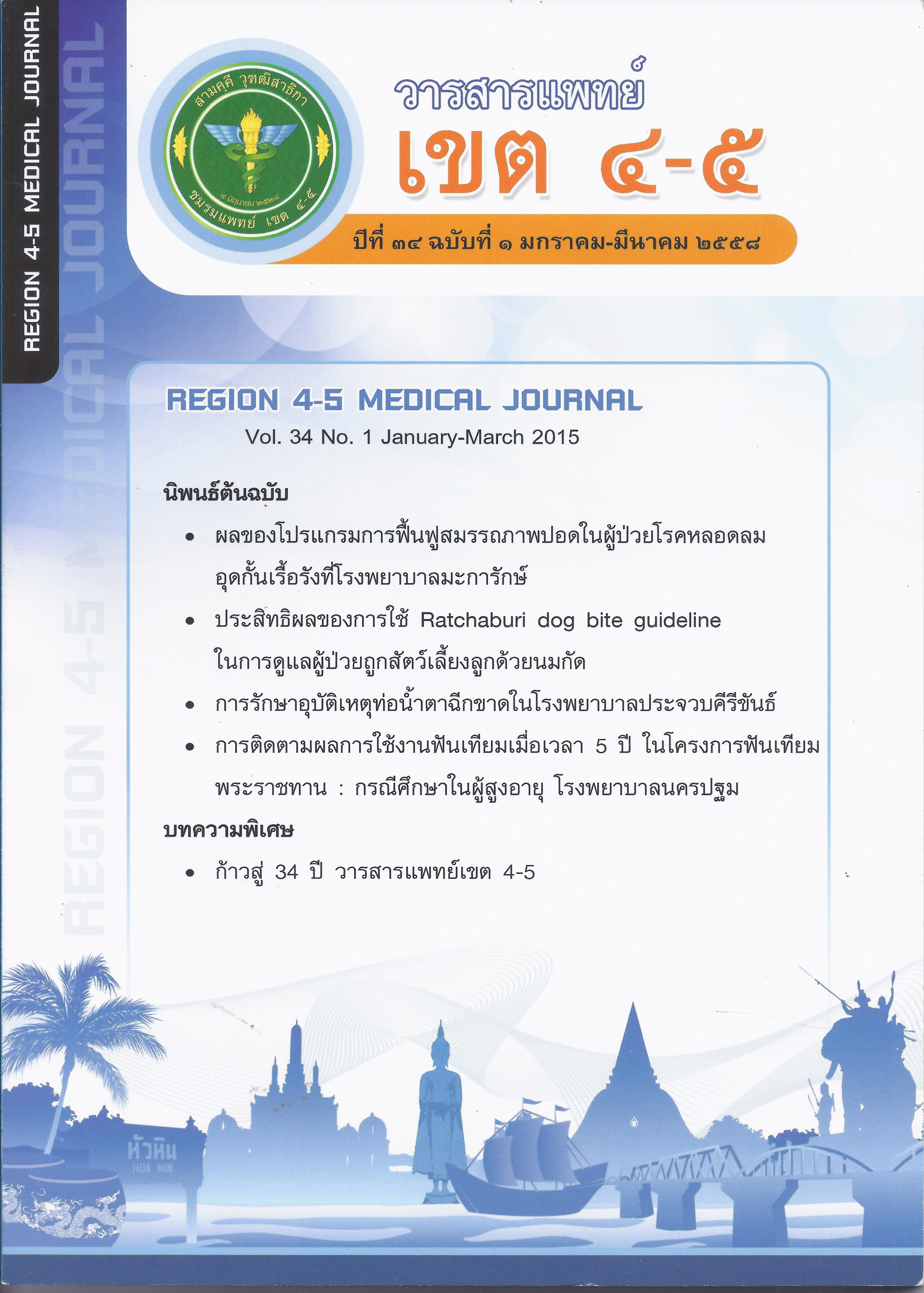บรรยายลักษณะและเปรียบเทียบความแตกต่างของเอกซเรย์ปอดในผู้ป่วยวัณโรคปอดตอบสนองต่อยา และผู้ป่วยดื้อยาในกลุ่มผู้ป่วยปลอดเชื้อ HIV
คำสำคัญ:
เอกซเรย์ปอด (ภาพถ่ายรังสีทรวงอก), วัณโรคปอด, การดื้อยาหลายชนิดบทคัดย่อ
จุดประสงค์ : เพื่อศึกษาลักษณะ และเปรียบเทียบความแตกต่างของภาพถ่ายเอกซเรย์ปอด ในผู้ป่วยวัณโรคปอดที่ตอบสนองต่อยา และผู้ป่วยวัณโรคปอดที่ดื้อต่อยาในกลุ่มผู้ป่วยปลอดเชื้อ HIV
วิธีการศึกษา : การศึกษาแบบ retrospective study เก็บรวบรวมข้อมูลผู้ป่วยวัณโรคปอดที่เสมหะพบเชื้อในโรงพยาบาลสมุทรสาคร ตั้งแต่ มกราคม ถึง ธันวาคม 2556 โดยรวบรวมข้อมูลจากเวชระเบียนผู้ป่วย ภาพถ่ายเอกซเรย์ปอด และผลทางห้องปฏิบัติการ นำข้อมูลมาวิเคราะห์ทางสถิติ
ผลการศึกษา : ผู้ป่วยวัณโรคปอดเสมหะพบเชื้อทั้งหมด 151 ราย ในจำนวนนี้มีผู้ป่วยวัณโรคปอดที่ตอบสนองยา จำนวน 130 ราย แบ่งเป็นเพศชาย 73 ราย เพศหญิง 57 ราย ช่วงอายุ 18-82 ปี (อายุเฉลี่ย 38 ปี) และกลุ่มผู้ป่วยวัณโรคปอดที่ดื้อต่อยา 21 ราย แบ่งเป็นเพศชาย 14 ราย และเพศหญิง 7 ราย ช่วงอายุ 21-78 ปี (อายุเฉลี่ย 43 ปี) ลักษณะเอกซเรย์ปอดที่พบมากที่สุดในผู้ป่วยกลุ่มวัณโรคปอดตอบสนองต่อยา คือ single lobar cavity (ร้อยละ 41.5) multilobar reticulonodular infiltration (ร้อยละ 36.2) single lobar consolidation (ร้อยละ 31.5) single lobar reticulonodular infiltration (ร้อยละ 31.5) ตามลำดับ และลักษณะเอกซเรย์ปอดที่พบมากที่สุดในกลุ่มผู้ป่วยวัณโรคปอดดื้อยา คือ multilobar reticulonodular infiltration (ร้อยละ 47.6) multilobar consolidation (ร้อยละ 42.8) multiple cavities (ร้อยละ 38) และ multiple bronchiectasis (ร้อยละ 23.8) ตามลำดับ ลักษณะของ multilobar consolidations (p=0.001) multiple cavities (p=0.025) multiple bronchiectasis (p=0.009) และ combined multilobar consolidations and multiple bronchiectasis (p=0.000) พบในวัณโรคปอดดื้อยามากกว่าวัณโรคที่ตอบสนองต่อยาอย่างมีนัยสำคัญทางสถิติ
สรุปผล : ลักษณะทางเอกซเรย์ปอด ที่บ่งชี้ผู้ป่วยวัณโรคปอดดื้อยาคือ multilobar consolidations multiple cavities และ multiple bronchiectasis ซึ่งถ้าพบร่วมกันสามารถเพิ่มความมั่นใจในการวินิจฉัยวัณโรคปอดติดเชื้อดื้อยาได้ สำหรับ specificity และ sensitivity ของ multilobar consolidations มีค่าร้อยละ 82 และร้อยละ 69 ตามลำดับ Multiple cavities and multiple bronchiectasis มีค่า specificity ร้อยละ 75 และร้อยละ 75 sensitivity ร้อยละ 57 และ ร้อยละ 83 ตามลำดับ
เอกสารอ้างอิง
2. สำนักควบคุมวัณโรค กระทรวงสาธารณสุข. แนวทางการวินิจฉัยและรักษาวัณโรคในประเทศไทย. กรุงเทพฯ: โรงพิมพ์ชุมนุมสหกรณ์การเกษตรแห่งประเทศไทย; 2552.
3. ศรีประพา เนตรนิยม. แนวทางการดำเนินงานควบคุมวัณโรคแห่งชาติ. กรุงเทพฯ: สำนักวัณโรค; 2556.
4. Akksilp S, Wattanaamornkiat W, Kittikraisak W, et al. Multidrug-resistant TB and HIV in Thailand: overlapping, but not independently associated, risk factors. Southeast Asian J Trop Med Public Health 2009;40(5):1000-14.
5. Geppert EF, Leff A. The pathogenesis of pulmonary and military tuberculosis. Arch Intern Med 1979;139(12):1381-3.
6. Diagnostic Standards and Classification of Tuberculosis in Adults and Children. This official statement of the American Thoracic Society and the Centers for Disease Control and Prevention was adopted by the ATS Board of Directors, July 1999. This statement was endorsed by the Council of the Infectious Disease Society of America, September 1999. Am J Respir Crit Care Med 2000;161(4 Pt 1):1376–95.
7. Udoh MO. Pathogenesis and morphology of tuberculosis. Benin J Postgrad Med 2009;11(1):91-6.
8. Cha J, Lee HY, Lee KS, et al.Radiological findings of extensively drug-resistant pulmonary tuberculosis in non-AIDS adults: comparisons with findings of multidrugresistant and drug-sensitive tuberculosis. Korean J Radiol 2009;10(3):207–16.
9. Brust JC, Berman AR, Zalta B, et al. Chest radiograph findings and time to culture conversion in patients with multidrug-resistant tuberculosis and HIV in Tugela Ferry, South Africa. PLoS One 2013;8(9):e73975.
10. Zahirifard S, Amiri MV, Bakhshayesh Karam M, et al. The radiological spectrum of pulmonary multidrugresistant tuberculosis in HIV-negative patients. Iran J Radiol 2003;1(3,4):161-6.
11. Chung MJ, Lee KS, Koh WJ, et al. Drugsensitive tuberculosis, multidrug-resistant tuberculosis, and non tuberculous mycobacterial pulmonary disease in non AIDS adults: comparison of thin-section CT findings. Eur Radiol 2006;16(9):1934-41.
12. Kim SH, Min JH, Lee JY. Radiological findings of primary multidrug-resistant pulmonary tuberculosis in HIV-seronegative patients. Hong Kong J Radiol 2014;17:4-8.
13. Blanchard JS. Molecular mechanisms of drug resistance in Mycobacterium tuberculosis. Annu Rev Biochem 1996;65:215-39.
14. David HL. Probability of distribution of drug-resistant mutants in unselected populations of Mycobacterium tuberculosis. Appl Microbiol 1970;20(5):810-4.
15. Bradford WZ, Daley CL. Multiple drugresistant tuberculosis. Infect Dis Clin North Am 1998;12(1):157-72.
16. McAdams HP, Erasmus J, Winter JA. Radiologic manifestations of pulmonary tuberculosis. Radiol Clin North Am 1995;33(4):655-78.
17. Eisenhuber E, Mostbeck G, Bankier A, et al. Radiologic diagnosis of lung tuberculosis. Radiologe 2007;47(5): 393-400.
18. Jeong YJ, Lee KS. Pulmonary tuberculosis: up-to-date imaging and management. AJR Am J Roentgenol 2008;191(3):834-44.
ดาวน์โหลด
เผยแพร่แล้ว
รูปแบบการอ้างอิง
ฉบับ
ประเภทบทความ
สัญญาอนุญาต
ลิขสิทธิ์บทความเป็นของผู้เขียนบทความ แต่หากผลงานของท่านได้รับการพิจารณาตีพิมพ์ลงวารสารแพทย์เขต 4-5 จะคงไว้ซึ่งสิทธิ์ในการตีพิมพ์ครั้งแรกด้วยเหตุที่บทความจะปรากฎในวารสารที่เข้าถึงได้ จึงอนุญาตให้นำบทความในวารสารไปใช้ประโยชน์ได้ในเชิงวิชาการโดยจำเป็นต้องมีการอ้างอิงถึงชื่อวารสารอย่างถูกต้อง แต่ไม่อนุญาตให้นำไปใช้ในเชิงพาณิชย์




